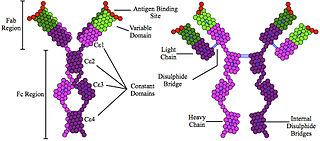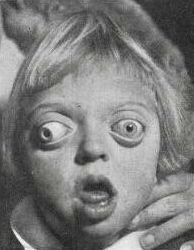
Physical therapy (PT), also known as physiotherapy, is a healthcare profession, as well as the care provided by physical therapists who promote, maintain, or restore health through patient education, physical intervention, disease prevention, and health promotion. Physical therapist is the term used for such professionals in the United States, and physiotherapist is the term used in many other countries.

The Hippocratic facies is the change produced in the face recognisable as a medical sign known as facies and prognostic of death. It may also be seen as due to long illness, excessive defecation, or excessive hunger, when it can be differentiated from the sign of impending death..
"[If the patient's facial] appearance may be described thus: the nose sharp, the eyes sunken, the temples fallen in, the ears cold and drawn in and their lobes distorted, the skin of the face hard, stretched and dry, and the colour of the face pale or dusky ... and if there is no improvement within [a prescribed period of time], it must be realized that this sign portends death."

De Quervain syndrome occurs when two tendons that control movement of the thumb become constricted by their tendon sheath in the wrist. This results in pain and tenderness on the thumb side of the wrist. Radial abduction of the thumb is painful. On some occasions, there is uneven movement or triggering of the thumb with radial abduction. Symptoms can come on gradually or be noted suddenly.
Persistent genital arousal disorder (PGAD), originally called persistent sexual arousal syndrome (PSAS), is spontaneous, persistent, unwanted and uncontrollable genital arousal in the absence of sexual stimulation or sexual desire, and is typically not relieved by orgasm. Instead, multiple orgasms over hours or days may be required for relief.

A unibrow is a single eyebrow created when the two eyebrows meet in the middle above the bridge of the nose. The hair above the bridge of the nose is of the same color and thickness as the eyebrows, such that they converge to form one uninterrupted line of hair.

Signs and symptoms are the observed or detectable signs, and experienced symptoms of an illness, injury, or condition.
Hypotonia is a state of low muscle tone, often involving reduced muscle strength. Hypotonia is not a specific medical disorder, but a potential manifestation of many different diseases and disorders that affect motor nerve control by the brain or muscle strength. Hypotonia is a lack of resistance to passive movement, whereas muscle weakness results in impaired active movement. Central hypotonia originates from the central nervous system, while peripheral hypotonia is related to problems within the spinal cord, peripheral nerves and/or skeletal muscles. Severe hypotonia in infancy is commonly known as floppy baby syndrome. Recognizing hypotonia, even in early infancy, is usually relatively straightforward, but diagnosing the underlying cause can be difficult and often unsuccessful. The long-term effects of hypotonia on a child's development and later life depend primarily on the severity of the muscle weakness and the nature of the cause. Some disorders have a specific treatment but the principal treatment for most hypotonia of idiopathic or neurologic cause is physical therapy and/or occupational therapy for remediation.

A coloboma is a hole in one of the structures of the eye, such as the iris, retina, choroid, or optic disc. The hole is present from birth and can be caused when a gap called the choroid fissure, which is present during early stages of prenatal development, fails to close up completely before a child is born. Ocular coloboma is relatively uncommon, affecting less than one in every 10,000 births.

Alagille syndrome (ALGS) is a genetic disorder that affects primarily the liver and the heart. Problems associated with the disorder generally become evident in infancy or early childhood. The disorder is inherited in an autosomal dominant pattern, and the estimated prevalence of Alagille syndrome is 1 in every 30,000 to 1 in every 40,000 live births. It is named after the French pediatrician Daniel Alagille, who first described the condition in 1969.

Cowden syndrome is an autosomal dominant inherited condition characterized by benign overgrowths called hamartomas as well as an increased lifetime risk of breast, thyroid, uterine, and other cancers. It is often underdiagnosed due to variability in disease presentation, but 99% of patients report mucocutaneous symptoms by age 20–29. Despite some considering it a primarily dermatologic condition, Cowden's syndrome is a multi-system disorder that also includes neurodevelopmental disorders such as macrocephaly.
Asymmetric crying facies (ACF), also called partial unilateral facial paresis and hypoplasia of depressor angula oris muscle, is a minor congenital anomaly caused by agenesis or hypoplasia of the depressor anguli oris muscle, one of the muscles that control the movements of the lower lip. This unilateral facial weakness is first noticed when the infant cries or smiles, affecting only one corner of the mouth and occurs on the left side in nearly 80% of cases.

Hyperimmunoglobulinemia E syndrome (HIES), of which the autosomal dominant form is called Job's syndrome or Buckley syndrome, is a heterogeneous group of immune disorders. Job's is also very rare at about 300 cases currently in the literature.

Zori–Stalker–Williams syndrome, also known as pectus excavatum, macrocephaly, short stature and dysplastic nails, is a rare autosomal dominant congenital disorder associated with a range of features such as pectus excavatum, macrocephaly and dysplastic nails, familial short stature, developmental delay and distinctive facies. Further signs are known to be associated with this syndrome.

In medical contexts, a facies is a distinctive facial expression or appearance associated with a specific medical condition. The term comes from Latin for "face". As a fifth declension noun, facies can be both singular and plural.

Coarse facial features is a constellation of facial features that are present in many inborn errors of metabolism.
Ulnar–mammary syndrome or Schinzel syndrome is a cutaneous condition characterized by nipple and breast hypoplasia, i.e. underdevelopment. Features of UMS can be mild to severe and can vary significantly from person to person, even within the same family. The main features of UMS include upper limb defects, underdevelopment of the apocrine and mammary glands, and various genital abnormalities. Other signs and symptoms may include hormonal deficiencies, delayed puberty, dental problems and obesity. People with UMS may have distinct facial features, including a wide face tapering to a prominent chin, and a broad nose.
Global developmental delay is an umbrella term used when children are significantly delayed in two or more areas of development. It can be diagnosed when a child is delayed in one or more milestones, categorised into motor skills, speech, cognitive skills, and social and emotional development. There is usually a specific condition which causes this delay, such as Cerebral Palsy, Fragile X syndrome or other chromosomal abnormalities. However, it is sometimes difficult to identify this underlying condition.
Long face syndrome, also referred to as skeletal open bite, is a relatively common condition characterised by excessive vertical facial development. Its causes may be either genetic or environmental. Long face syndrome is "a common dentofacial abnormality." Its diagnosis, symptomology and treatments are complex and controversial. Indeed, even its existence as a "syndrome" is disputed.

DiGeorge syndrome, also known as 22q11.2 deletion syndrome, is a syndrome caused by a microdeletion on the long arm of chromosome 22. While the symptoms can vary, they often include congenital heart problems, specific facial features, frequent infections, developmental delay, intellectual disability and cleft palate. Associated conditions include kidney problems, schizophrenia, hearing loss and autoimmune disorders such as rheumatoid arthritis or Graves' disease.












